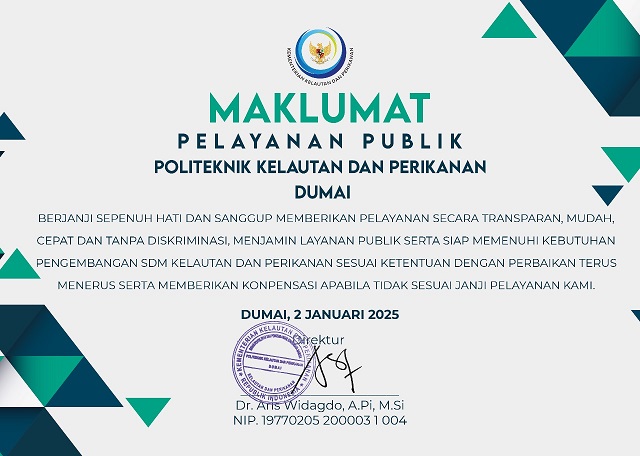IDENTIFICATION OF THE PRESENCE OF DUGONG, SEAGRASS HABITAT, AND THREATS IN THE WATERS OF BANTEN PROVINCE
Abstract
Keywords
Full Text:
PDFReferences
Astuti, N., & Putra, I. (2022). Pengaruh Aktivitas Manusia Terhadap Populasi Penyu di Wilayah Pesisir Banten. Jurnal Kelautan dan Perikanan Indonesia, 15(2), 123-135.
Azkab, M. H. (1998). Duyung Sebagai Pemakan Lamun. Oseana. 23 (3 dan 4) : 35 – 39.
Azwar, M. (2021). Upaya World Wide Fund For Nature dalam Konservasi Dugong dan Lamun di Indonesia Periode 2016-2019. Skripsi. Universitas Islam Negeri Syarif Hidayatullah. Jakarta. 146 hal.
Banten Marine and Fisheries Research Center. (2023). Laporan Tahunan Penelitian Biota Laut di Teluk Banten. Banten Marine and Fisheries Research Center.
Briscoe, D.K, Hiatt S, Lewison R, Hines E. (2014). Modelling Habitat and Bycatch for Dugongs in Sabah, Malaysia. Endang Species Res. 24: 237-247.
Dewi, C.S.U., B. Subhan, & D. Arafat. (2018). Distribusi habitat pakan dugong dan ancamannya di Indonesia. J. Of Fisheries and Marine Science, 2(2):128-136.
Hasan, I. (2001). Pokok-Pokok Materi Statistik 1 (Statistik Deskriptif). Jakarta : PT Bumi Aksara.
Hartono, M., & Dewi, S. (2020). Tantangan Konservasi Lumba-lumba di Perairan Indonesia: Studi Kasus di Teluk Banten. Jurnal Biologi Tropis Indonesia, 8(1): 87-96.
Heinsohn G.E, Wake J, Marsh H, Spain A.V. (1977). The Dugong (Dugong dugon (Muller)) in the Seagrass System. Aquaculture 12: 235–248.
Herlambang, M. P., & Wibowo, S. (2019). Rapid Urbanization in Banten Coastal Area: Impacts and Environmental Challenges. Journal of Indonesian Urban Development, Vol. 8(3): 45-60.
International Union for Conservation of Nature (IUCN). (2015). Dugong dugon. The IUCN Red List of Threatened Species. https://www.iucnredlist.org.
Khalifa, M.A. (2011). Tingkah Laku dan Karakteristik Suara Dugong dugon di Sea World Indonesia. [Skripsi]. Bogor: Fakultas Perikanan dan Ilmu Kelautan-Institut Pertanian Bogor.
Khalifa M.A. (2014). Kondisi Habitat dan Kehidupan Pesut di Teluk Banten. [Tesis]. Bogor: Sekolah Pasca Sarjana-Institut Pertanian Bogor.
Khalifa M.A, Kamal M.M, Adiwilaga E.M, Sunuddin A. (2014). Preliminary Study on the Distribution of Irrawady Dolphin, Orcaella brevirostris¸in Banten Bay. Open Journal of Marine Science 4: 338-343.
Kuo, J. (2007). New monoecious seagrass of halophila sulawesii (hydrocharitaceae) from Indonesia. Aquatic Botany, 87(2): 171-175.
Lembaga Ilmu Pengetahuan Indonesia (LIPI). (2020). Status dan Konservasi Hiu dan Paus di Indonesia. Jakarta: LIPI.
[LIPI] Lembaga Ilmu Pengetahuan Indonesia. (2001). Laporan Penelitian Wilayah Pesisir Teluk Banten Tahap Kedua. Jakarta (ID): Lembaga Ilmu Pengetahuan Indonesia.
[LIPI] Lembaga Ilmu Pengetahuan Indonesia. (2016). “Reklamasi dan Dampaknya Terhadap Padang Lamun di Pulau Pari serta Transplantasi Lamun dalam kegiatan Wisata Edukasi Kelautan sebagai solusi dan Awareness Campaign”, Loka Pengembangan Kompetensi Sumberdaya Manusia Oseanografi.
Marsh H, C. Eros, P. Corkeron and B. Breen. (1999). “A conservation strategy for dugongs: Implications of Australian research”, CSIRO Marine and Freshwater Research, Vol.50, No.8, :979–990.
Marsh H, Penrose H, Eros C, Hugues J. (2002). Dugong Status Report and Action Plans for Country and Territories. United Nations Environment Programme World Conservation Monitoring Centre. Cambridge.
Moraal M dan de Iongh H.H. (2007). The Dugong in Indonesia. Preliminary Report on The National Dugong Conservation Strategy and Action Plan for Indonesia. Jakarta. 41p.
Nasr D.; Shawky A. M. and Vine P. (2019). Status of Red Sea Dugongs. In: Rasul NMA, Stewart ICF (eds) Oceanographic and Biological Aspects of the Red Sea. Springer International Publishing, Cham. Switzerland, pp. 327–354
Nellemann C, Corcoran E, Duarte C.M, Valdés L, De Young C, Fonseca L, Grimsditch G. (2009). Blue Carbon, A Rapid Response Assessment, United Nations Environment Programme. GRID-Arendal, Norway. 80p.
Octavina, C., M. R. Fazillah, M. Ulfah, S. Purnawan dan A.W. Perdana. (2020). Keragaman Lamun Sebagai Potensi Pakan Dugong dugon di Teluk Lamteng, Kabupaten Aceh Besar. Jurnal Ilmu dan Teknologi Kelautan Tropis. Vol. 12 (1): 69-79.
Pilcher N.J dan Kwan D. (2012). Dugong Questionnaire Survey Project Manual. CMS-UNEP Abu Dhabi Office. United Arab Emirates. 44p.
Rencana Strategis 2014-2019. Kementerian Kelautan dan Perikanan, [dokumen online] tersedia di https://kkp.go.id/ancomponent/media/uploadgambarpendukung/djprl/PUBLIKASI/RenstraPRLTa hun2014-2019finale-1.pdf; Internet; diunduh pada 27 September 2024.
Rakhmat, J.(2005). Psikologi Komunikasi. Bandung: PT. Remaja Rosdakarya.
Sukardi, N.M.R. (2024). Pengaturan dan Penataan Kelautan dan Kemaritiman di Era Globalisasi. Kertha Wicaksana. . KERTHA WICAKSANA: Sarana Komunikasi Dosen dan Mahasiswa. 18 (1). 96-100.
Suryana, A., & Ramadhan, L. (2021). Dampak Penangkapan Ikan Terhadap Mamalia Laut di Teluk Banten. Indonesian Journal of Marine Science, 10(4), 298-310.
[UNEP] United Nations Environment Programme. (2017). Saving Sea Cows Helps Ensure Human Food Security. [artikelonline] https://www.unenvironment.org/news-and-stories/story/saving-sea-cows-helps-ensurehuman-food-security; Internet; diakses pada 27 September 2024.
DOI: http://dx.doi.org/10.15578/aj.v6i2.15021
Refbacks
- There are currently no refbacks.
Public Services

Citation
Pusat Penelitian dan Pengabdian Kepada Masyarakat
Politeknik Kelautan dan Perikanan Dumai
Jl. Wan Amir No. 1, Kel. Pangkalan Sesai, Kec. Dumai Barat, Kota Dumai
Telp/Fax: (0765) 4300443
This work is licensed under a Creative Commons Attribution-ShareAlike 4.0 International License.
View My Stats


















